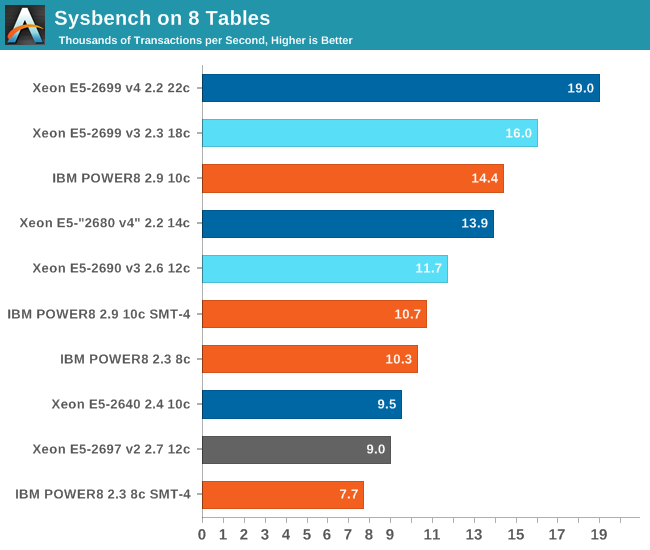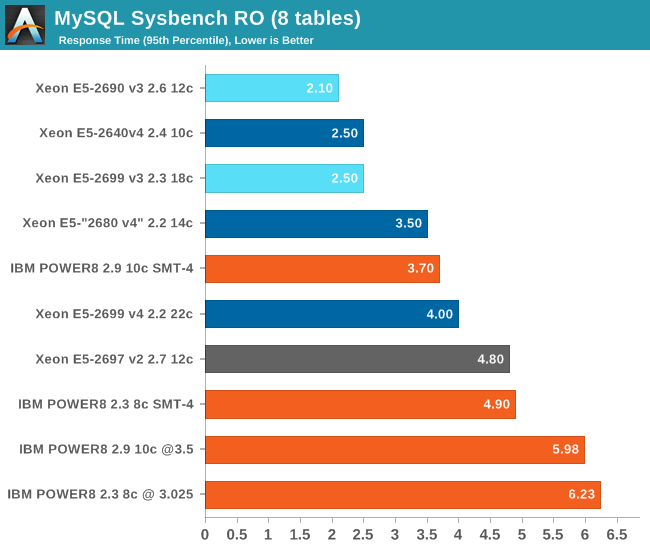The OpenPOWER Saga Continues: Can You Get POWER Inside 1U?
by Johan De Gelas on February 24, 2017 8:00 AM ESTDatabase Performance: MySQL 5.7.0
Thanks to the excellent repository of Percona, we have been able to vastly improve our MySQL benchmarking with Sysbench. You cannot compare these results to the results published prior to the Cavium Thunder-X review: we made quite a few changes in the way we benchmark. We first upgraded the standard MySQL installation to the better performing Percona Server 5.7.
Secondly, we used Sysbench 0.5 (instead of 0.4) and we implemented the (lua) scripts that allow us to use multiple tables (8 in our case) instead of the default one. This makes the Sysbench benchmark much more realistic, as running with one table creates a very artificial bottleneck.
For our testing we used the read-only OLTP benchmark, which is slightly less realistic, but still much more interesting than most other Sysbench tests. This allows us to measure CPU performance without creating an I/O bottleneck.

The 10-core POWER8 @3.5 GHz is about 40% faster than the 8-core POWER8, which maxes out at 3.025 GHz. This is in-line with our performance expectations. As it turns out, keeping the clock high is not very hard in this kind of application: the application peaks for a relatively small period.
Overall our "1U" POWER8 server is only 8% faster than the Xeon E5-2640v4. Meanwhile reducing the number of threads to 4 is not a wise thing to do.

Although we cannot say that our 8-core "1U" POWER8 setup is much slower than the 10-core S812LC, it still gets a firm beating by the Xeon E5-2640v4.










28 Comments
View All Comments
Amandtec - Friday, February 24, 2017 - link
Only an amateur here but I did read some of your previous articles on this. I thought the big advantage of POWER was it was encouraging 3rd parties to bring ASIC's into their server space, while Intel wan't to own the whole hardware setup? Surely ASIC's is where the whole performance per watt game ends - see Bitcoin mining.ddriver - Friday, February 24, 2017 - link
There is nothing preventing you from building your own accelerators and hooking them to a free PCIE slot.JohanAnandtech - Friday, February 24, 2017 - link
True. But you have only one PCIe 8x and AFAIK it is not an OpenCAPI one, nor an NVME capable.JohanAnandtech - Friday, February 24, 2017 - link
I meant NVLink, not NVME :-)SarahKerrigan - Friday, February 24, 2017 - link
The GT75 is a weird system and I've never been clear on why it exists. The Supermicro 1U (S821LC) at least gets you two CPU's for cheap in 1U... I'm not overly surprised by poor performance here. This is a 130W CPU, not a 170 as Anandtech says, running at low clocks. 170 is only the turbo power. I'm also guessing it's loud as hell with those fans.That being said - Anandtech also has a history of interestingly Intel-centric interpretations of results. Remember when Intel's uarch was "a lot more sophisticated" than P8 according to Anandtech based purely on ST 7zip results, and then when ThunderX did well on 7zip, Anandtech said 7z was a meaningless benchmark irrelevant to server workloads? I've also noticed that since gcc's Power output improved (~4000 MIPS single-thread compression with gcc 6.2 on 3.3GHz P8), 7zip has conveniently vanished from Anandtech's Power reviews. The idea of drawing conclusions about microarchitectures based on a balance of a range of tests seems alien to them. Looked at through that lens, Power8 (well, in systems not named GT75 :P) looks decent at some things, less decent at others, but overall pretty good. Database perf/W, per Anandtech's testing, is better than Haswell. This isn't a bad place for P8 to be, considering it's been shipping since early 2014 and is on the verge of replacement.
Tl;dr - GT75 is a turd but Anandtech sees what they want to see. I have to wonder if Ryzen is going to be reviewed the same way.
JohanAnandtech - Friday, February 24, 2017 - link
7zip is indeed a bad indicator for server performance, but at the time, we only had access to a virtual machine on top of a POWER8 with 2 GB of RAM and we thought it might give us a first glimpse of what the P8 was capable off.As time progressed, we understood that is mostly a TLB/latency sensitive benchmark. So it has no place in a server oriented article, it is mostly interesting to discuss micro arch details.
Ian Cutress - Friday, February 24, 2017 - link
Anandtech has different editors focusing on different areas - Johan on Server, I'm on CPU, Matt on mobile, etc. Feel free to reach out via email if you have suggestions for us.Kevin G - Friday, February 24, 2017 - link
This isn't the best showing of POWER8. Those chips need robust cooling to keep their clock speeds up to be competitive. The 1U form factor does place a lot of constraints on the design.As for the Tyan system itself, I'm kinda of surprised that they went with the Centaur buffer that uses DDR3 as IBM has reportedly been shipping buffers that support DDR4 for nearly half a year now. That'd lower power consumption greatly, though likely not enough to be competitive with Intel on a system level performance/watt metric. Moving to DDR4 would give the system a massive increase in memory capacity as 128 GB LR DDR4 DIMMs are shipping with 256 GB LR DIMMs on the horizon. Using 256 GB DIMMs, a system like this would support 8 TB which is a lot for a 1U server.
Considering the internals of the system I'm not surprised but a secondary PSU option would have been nice, even if it was external. PSU redundancy is remarkably common, even for 1U systems.
I'd also be worried about IO performance on this system with all the networking and SATA ports hanging off of a single PCIe uplink to the CPU.
I do agree with the conclusion that POWER9 looks to be very promising. The nice thing is that IBM is going to be offering both the SMT4 and SMT8 cores in both types of sockets (essentially four different dies!).
ddriver - Saturday, February 25, 2017 - link
Form factor wont change the facts - it is a power, it is too expensive, and it is too slow. Power sounds great on paper, but it doesn't seem to deliver in practice.Kevin G - Tuesday, February 28, 2017 - link
Form factor does matter when it changes the cooling system which in turn can invoke thermal throttling.Even on the x86 side of things, half wide 2U servers are popular as they can use larger fans despite having the same effective density as a full width 1U server. The increased air flow into a chassis is great for keepings cools and helps maintain high turbo levels for performance.